Picture this: It’s a gloomy winter day in the UK, rain pouring outside, and the cold seeping in through the windows. You’re curled up under a cozy blanket, sipping a hot cup of tea, and admiring the vibrant orange flowers of your Calathea Crocata, also known as the Eternal Flame Plant. Its tropical foliage brings a burst of color and warmth to your home, reminding you of sun-soaked rainforests.
Caring for this stunning plant may seem challenging, but fear not. In this guide, I will share expert tips on how to care for your Calathea Crocata and help it thrive in the UK climate. From providing the right light conditions to maintaining proper moisture levels, get ready to become a plant care aficionado and enjoy the beauty of the Eternal Flame Plant all year round.
Appearance of Calathea Crocata (Eternal Flame Plant)
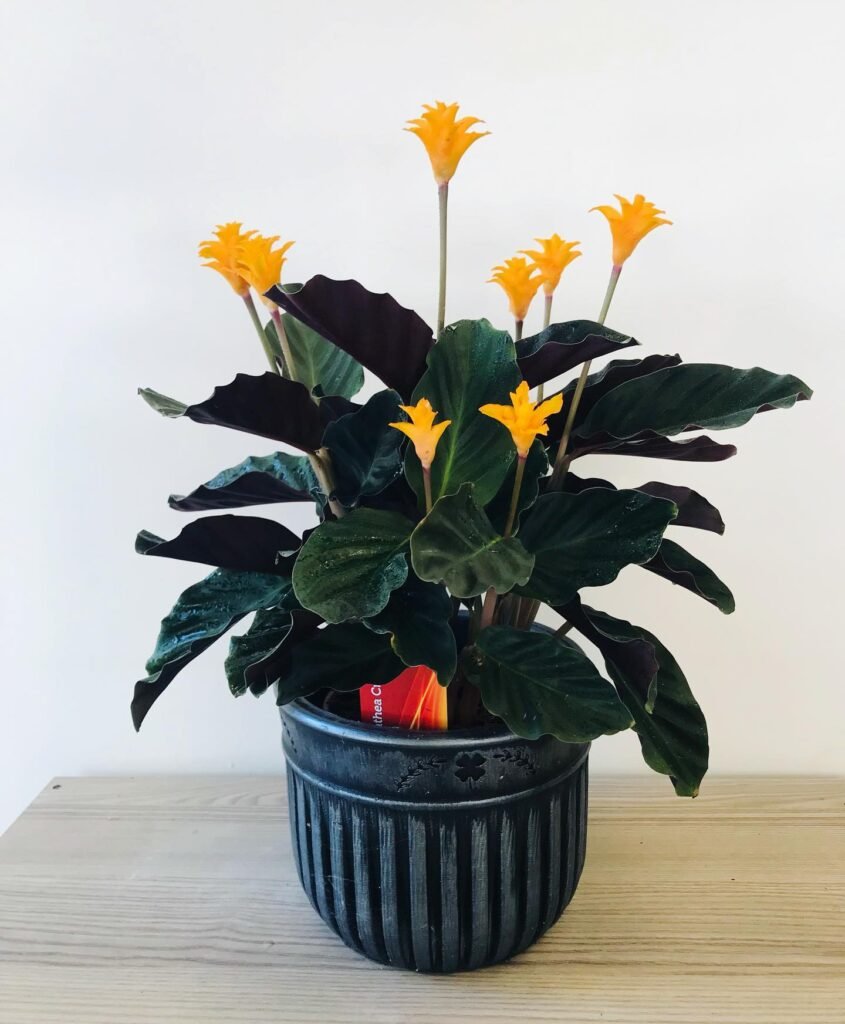
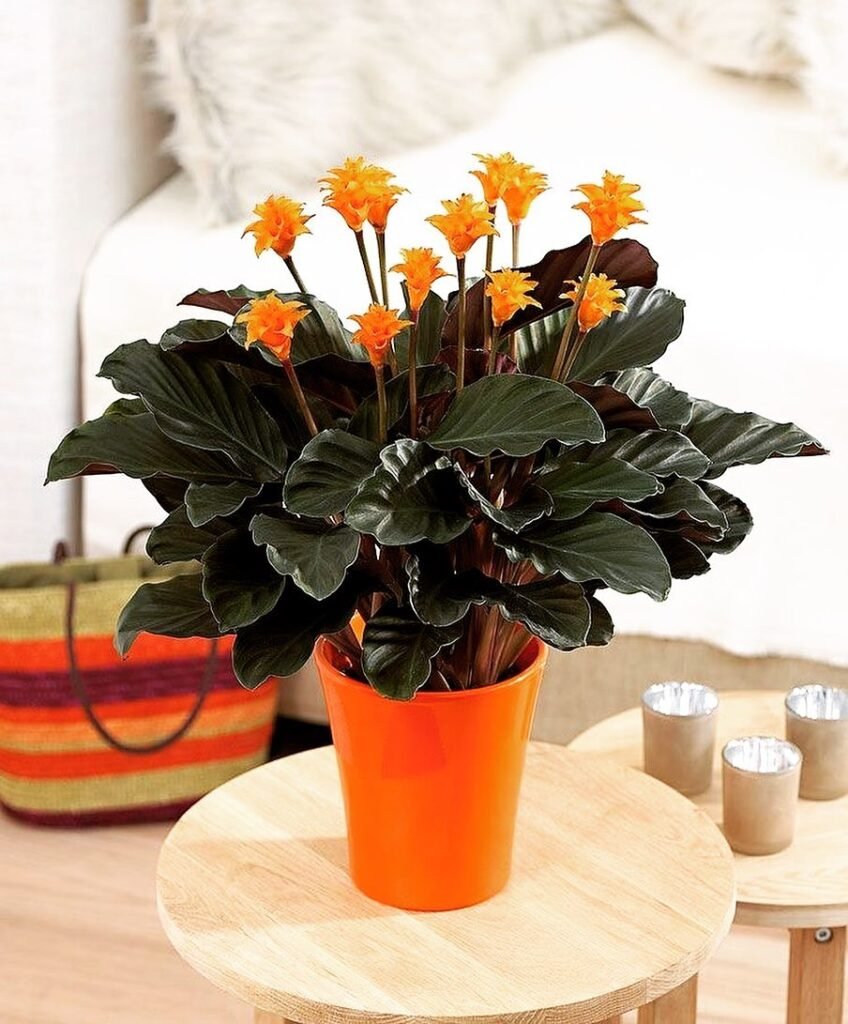
Calathea Crocata, also known as the Eternal Flame Plant, is a stunning clump-forming, evergreen perennial native to the vibrant rainforests of Brazil. With its lush tropical foliage and striking orange flowers, this plant is a true showstopper.
The Calathea Crocata can grow up to 60cm tall and 40cm wide, creating an impressive presence in any room. Its elliptic-shaped leaves have a deep green color on the upper side, while the underside displays captivating crimson-purple shades.
But the real star of the show is undoubtedly the plant’s breathtaking flowers. Resembling flames, these radiant orange blooms sit atop long stalks and can last for up to 3 months, adding a splash of vibrant color to your indoor garden.
- Clump-forming, evergreen perennial native to Brazil
- Up to 60cm tall and 40cm wide
- Elliptic-shaped leaves with deep green color on the upper side
- Crimson-purple shades on the underside of the leaves
- Beautiful orange flowers resembling flames
- Flowers can last up to 3 months
 Did you know the Calathea Crocata is prized for its vibrant orange flowers that stand out beautifully against its dark green leaves? This unique blooming characteristic, coupled with its air-purifying abilities, makes it a distinguished addition to any indoor plant collection.
Did you know the Calathea Crocata is prized for its vibrant orange flowers that stand out beautifully against its dark green leaves? This unique blooming characteristic, coupled with its air-purifying abilities, makes it a distinguished addition to any indoor plant collection.
Light Requirements for Calathea Crocata
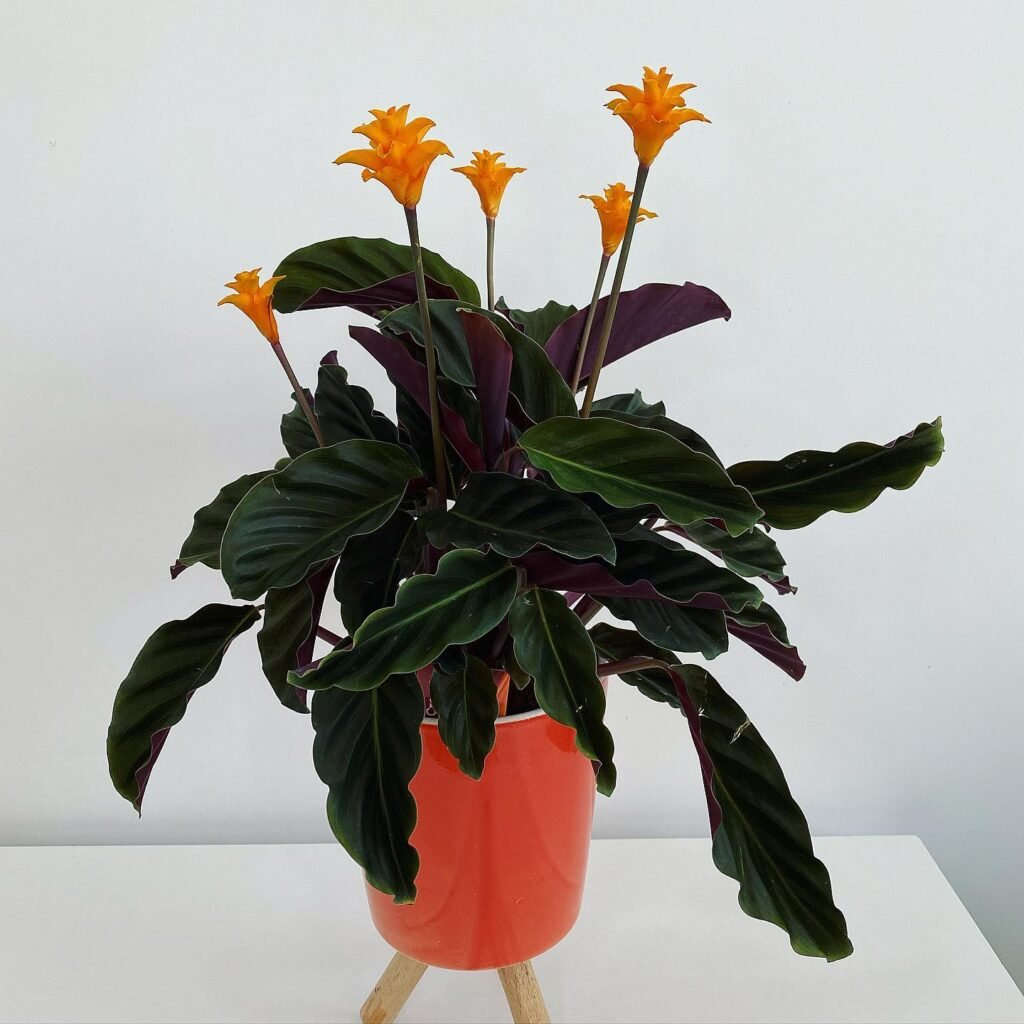
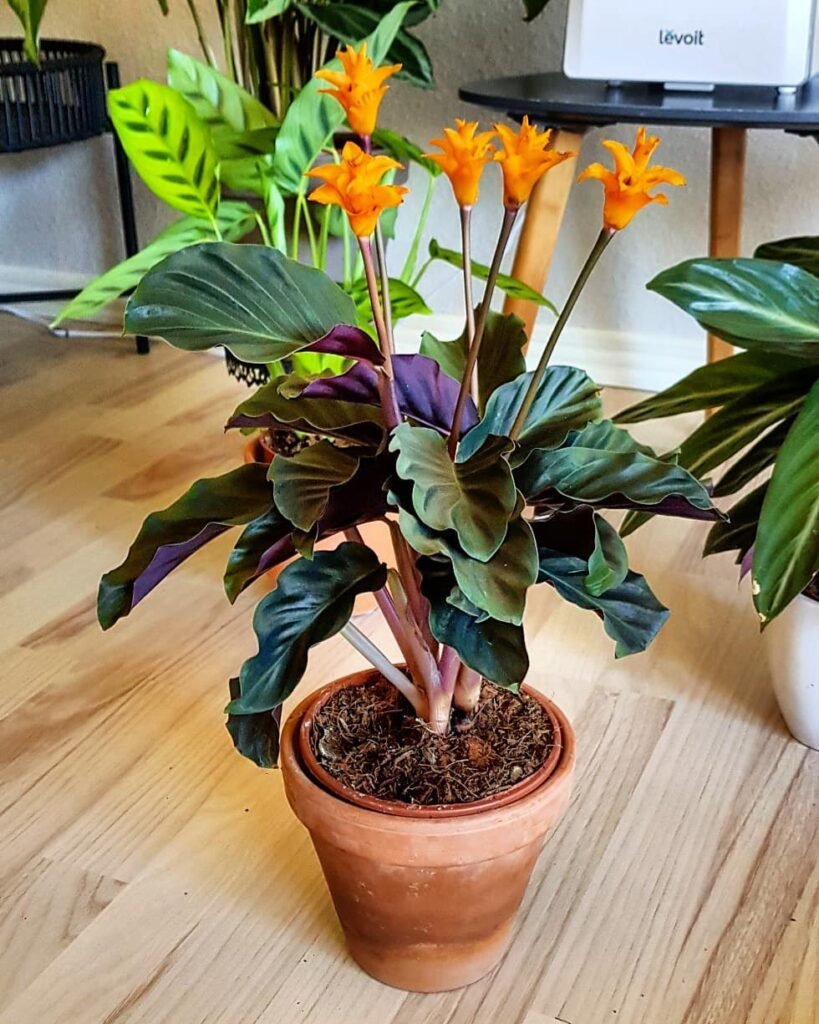
Calathea Crocata, also known as the Eternal Flame Plant, is a stunning addition to any indoor plant collection. To ensure the plant’s health and vibrant floral display, it is important to understand its light requirements.
Calathea Crocata thrives in bright but indirect sunlight. Placing it near a window with plenty of natural light is ideal. However, it is crucial to protect the plant from direct sunlight, as this can cause the leaves to scorch or fade.
An east or west-facing window is the perfect location for your Calathea Crocata, as it provides the right amount of light without exposing it to harsh rays. This ensures that the plant receives enough light for photosynthesis while maintaining its overall well-being.

Watering Tips for Calathea Crocata (Eternal Flame Plant)


Calathea Crocata, also known as the Eternal Flame Plant, thrives in a moist environment. To keep your Calathea Crocata healthy and happy, it is important to ensure the soil remains consistently moist.
However, be careful not to overwater, as this can lead to root rot. A good rule of thumb is to water the plant when the top inch of soil feels dry to the touch.
In addition to watering, providing high humidity is beneficial for your Calathea Crocata. You can increase humidity levels by either misting the leaves with room temperature water or placing a tray of water and pebbles near the plant. This helps create a microclimate that mimics the plant’s natural habitat.

Fertilizing and Soil for Calathea Crocata
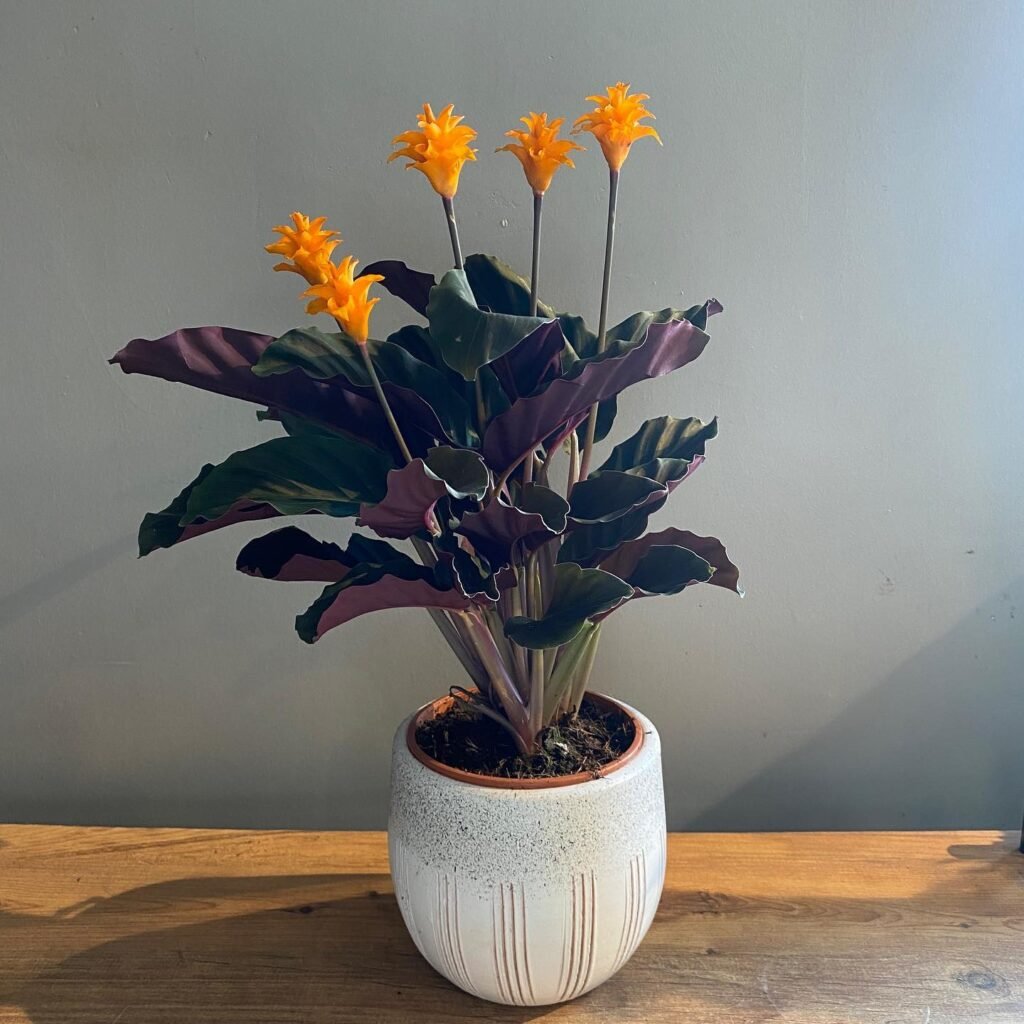
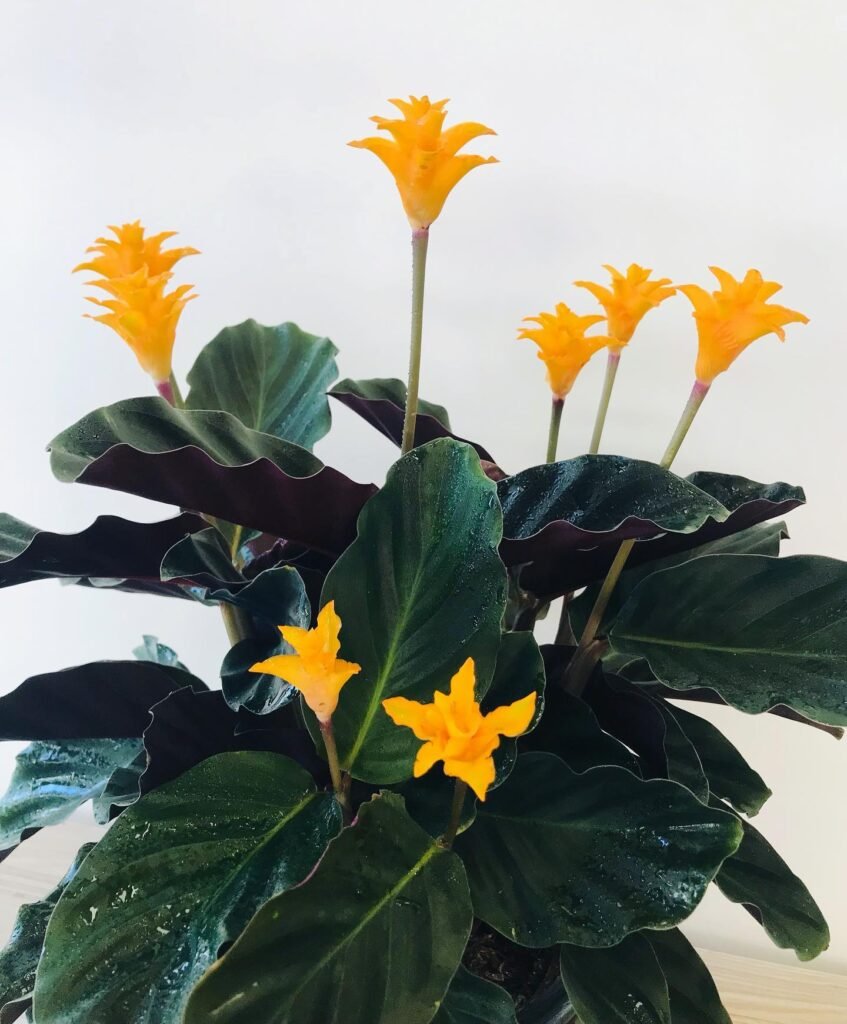
Calathea Crocata, also known as the Eternal Flame Plant, benefits from regular fertilizing during the growing season in the UK, which is spring and summer. To provide essential nutrients to the plant, I recommend using phosphorus-reduced liquid fertilizer every month.
When it comes to soil, Calathea Crocata thrives in a nutrient-rich and well-draining soil. To achieve this, I suggest using a soil-based potting compost with some peat moss. This combination provides the plant with the necessary nutrients and ensures proper drainage, which is crucial for the health and overall well-being of your Calathea Crocata.

Pruning and Maintenance for Eternal Flame Plant

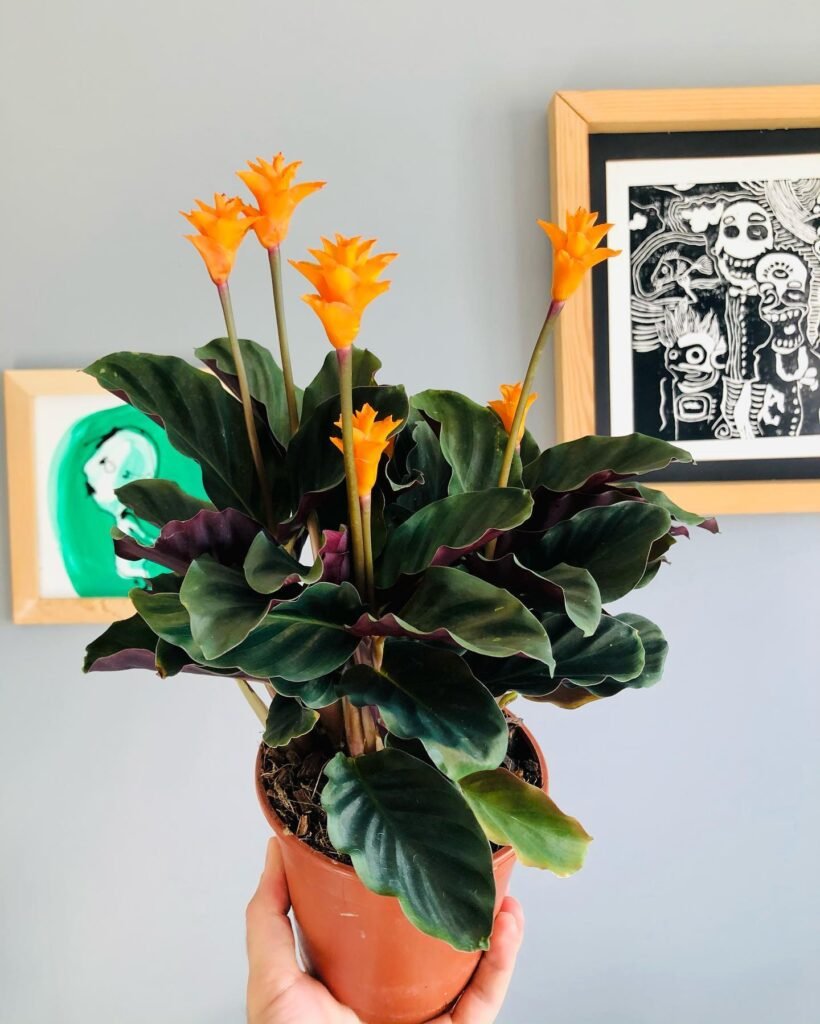
When it comes to Calathea Crocata (Eternal Flame Plant), pruning is not a necessity, but it can help keep your plant looking neat and encourage healthy growth. One important aspect of maintenance is the removal of dead or damaged leaves. By doing so, you can maintain the plant’s overall appearance and prevent any potential disease or pest issues.
If your Calathea Crocata has flower spikes, it is advisable to cut them down to the base of the plant at the end of the growing season. This allows the plant to focus its energy on new growth and ensures a healthier future blooming cycle.
In addition to pruning, you can also encourage a second bloom by simulating short-day conditions after the first bloom. This involves covering the plant for 14 hours during the night and providing only 10 hours of daylight. This manipulation of light and darkness can stimulate the plant to produce another round of beautiful flowers, enhancing the visual appeal of your Calathea Crocata.
Maintenance Tips
- Remove dead or damaged leaves to maintain a tidy appearance.
- Cut down flower spikes at the end of the growing season to promote healthy growth.
- Simulate short-day conditions by adjusting the light cycle to encourage a second bloom.

Propagating Calathea Crocata (Eternal Flame Plant)


In order to propagate Calathea Crocata, there are two main methods that can be used: division or seed propagation. Division is the simpler and more commonly used method, and it is best done during the spring when repotting the plant. Here’s how to go about it:
- Start by carefully removing the Calathea Crocata from its current pot.
- Inspect the plant and identify areas where it can be divided into smaller sections.
- Ensure that each section has at least one leaf and a sprout with roots.
- Pot up each section individually in a well-draining soil.
- Provide these new divisions with the appropriate conditions for growth, including bright but indirect sunlight and regular watering.
While division is the preferred propagation method, it is worth noting that seed propagation can also be attempted. However, this method can be more challenging as Calathea Crocata seeds are not widely available. If you do manage to obtain seeds, here’s what you can try:
- Gently press Calathea Crocata seeds into the surface of a moist, well-draining soil mixture.
- Cover the container with a plastic lid or wrap it in a plastic bag to create a humid environment.
- Place the container in a warm location with indirect sunlight.
- Keep the soil consistently moist but avoid overwatering.
- With patience and proper care, the seeds should eventually germinate and grow into new Calathea Crocata plants.
Whether you choose to propagate through division or seed propagation, remember to provide the new plants with the same care and attention as their parent plant. With the right conditions, your Calathea Crocata family will continue to thrive and bring beauty to your indoor space.

Repotting Tips for Calathea Crocata
Repotting your Calathea Crocata is an important part of its care routine. It should be done every other year in the spring to ensure its continued growth and health. Here are some helpful tips to guide you through the repotting process.
- Choose the right time: Repot your Calathea Crocata during the spring when it is actively growing. This allows the plant to recover and adjust to its new environment more easily.
- Select a larger pot: When repotting, choose a slightly larger pot than the previous one. This will give the roots room to grow and prevent overcrowding. However, avoid using a pot that is too large, as it can retain too much water and lead to root rot.
- Use well-draining soil: Calathea Crocata prefers a well-draining soil to prevent waterlogged roots. Opt for a lightweight potting mix that contains ingredients such as peat moss, perlite, or vermiculite. This will ensure excess water can drain away, keeping the roots healthy.
- Create a drainage layer: To further facilitate water movement, place a layer of small pebbles at the bottom of the pot before adding the soil. This helps to prevent water from sitting in the bottom of the pot, which can also lead to root rot.
 Were you aware that the Calathea Crocata is also called ‘Tassmania‘ in some regions? This unique nickname highlights its exotic appeal and the fascinating diversity within the Calathea family.
Were you aware that the Calathea Crocata is also called ‘Tassmania‘ in some regions? This unique nickname highlights its exotic appeal and the fascinating diversity within the Calathea family.
Common Diseases and Pests of Calathea Crocata
Calathea Crocata, like many houseplants, is susceptible to common diseases and pests that can affect its health and appearance. One of the most common pests that infest this plant is the red spider mite. These tiny creatures feed on the sap of the leaves, causing damage and discoloration. Regularly inspect the leaves for any signs of infestation, such as webbing or tiny moving dots on the undersides of the leaves. If detected, take immediate action to address the issue.
In addition to pests, overwatering can also pose a threat to the well-being of your Calathea Crocata. Overwatering can lead to root rot, which is characterized by brown spots on the leaves. To prevent this, make sure to allow the top inch of soil to dry out before watering again. It is important to strike a balance between providing adequate moisture and avoiding excessive watering.
Another factor that can affect the health of your plant is humidity. Calathea Crocata thrives in high humidity environments. If the air is too dry, the leaves can develop brown spots. To increase humidity levels, you can mist the leaves regularly or place a tray of water and pebbles near the plant. This will help create a more favorable environment for your Calathea Crocata to grow and thrive.
Helpful Videos about Calathea Crocata (Eternal Flame Plant)
Check out these engaging videos I found, dedicated to the care of the Calathea Crocata (Eternal Flame Plant). With easy-to-follow tips and tricks, they’re perfect for novice gardeners looking to begin their journey in plant care.
- Calathea Crocata Tassmania Care Guide and Species Spotlight ~ Eternal Flame
- Raiding the Rack 2 – Geoppertia Crocata (Eternal flame / Calathea crocata Tassmania ) + More..
FAQ about Calathea Crocata (Eternal Flame Plant)

Wondering about the best practices for caring for your Calathea Crocata (Eternal Flame Plant)? You’ve landed in the perfect spot! I’ve gathered all the essential questions to assist you in nurturing your plant with ease. From mastering the ideal watering schedule to addressing common challenges, you’re in capable hands.
The Eternal Flame Plant thrives in indirect, bright light. Avoid direct sunlight, which can scorch its leaves. A north-facing window or a spot receiving filtered light is perfect.
Water when the top inch of soil feels dry to the touch. Calathea Crocata prefers consistent moisture, but be wary of overwatering to prevent root rot. In the UK climate, this might mean watering once a week, adjusting for humidity and temperature.
Yes, it flourishes in high humidity. In the typically drier UK homes, you might need to increase humidity by misting the plant regularly, placing it on a pebble tray filled with water, or using a humidifier.
Keep it in a warm environment, ideally between 18°C to 24°C. Avoid draughty areas or sudden temperature changes, which are common in UK homes.
Repot in spring every couple of years or when it outgrows its pot. Use a potting mix with good drainage and choose a pot only slightly larger than the previous one to avoid overwatering issues.
Leaf curling is often a sign of underwatering or low humidity. Check the soil moisture and consider increasing humidity around the plant.
Symptoms of overwatering include yellowing leaves, a mushy base, or a mouldy smell from the soil. Ensure good drainage and let the topsoil dry out slightly between waterings.
Keep an eye out for spider mites and mealybugs. Wipe the leaves with a damp cloth regularly and treat infestations with neem oil or insecticidal soap.
Brown tips can indicate low humidity or fluoride in the water. Try using distilled or rainwater and increase humidity around the plant.
Calathea Crocata is non-toxic and safe for pets. However, it’s still best to keep it out of reach to avoid any accidental ingestion of leaves, which could cause mild stomach upset.
Ensure your plant receives adequate light (but not direct sunlight), maintain high humidity, and feed with a balanced fertiliser during the growing season to encourage vibrant blooms.
Use a well-draining, peat-based potting mix. The soil should retain moisture but allow excess water to drain to prevent root rot.
Fading leaves can result from too much direct sunlight. Move your plant to a location with bright, indirect light.
Propagate by division during repotting. Gently separate the plant into smaller sections, ensuring each has roots, and pot them separately.
It’s best grown indoors due to the UK’s cooler climate. If placed outside during summer, ensure it’s in a shaded, protected spot and bring it indoors before temperatures drop.
Good air circulation, proper watering, and avoiding wet leaves can prevent most fungal diseases. Treat any infections with fungicidal sprays and remove affected areas.
Ensure it’s not in too dark a spot and that you’re not over or under-watering. Also, a boost in phosphorus-rich fertiliser can encourage blooming.
I trust this FAQ has shed light on the essentials of nurturing your Calathea Crocata (Eternal Flame Plant). Should you find yourself with further queries, please do pop them in the comments. I’m at your service. Bear in mind, we all embark as novices in the enchanting garden of botany, continually discovering as we foster our verdant companions. Happy gardening !

